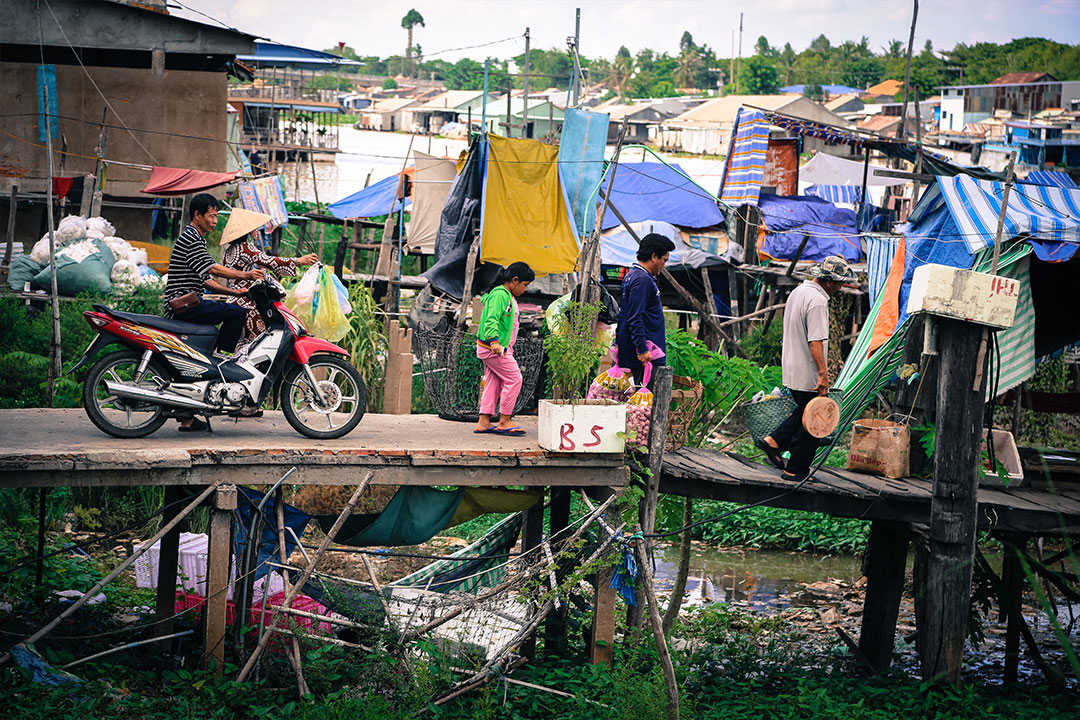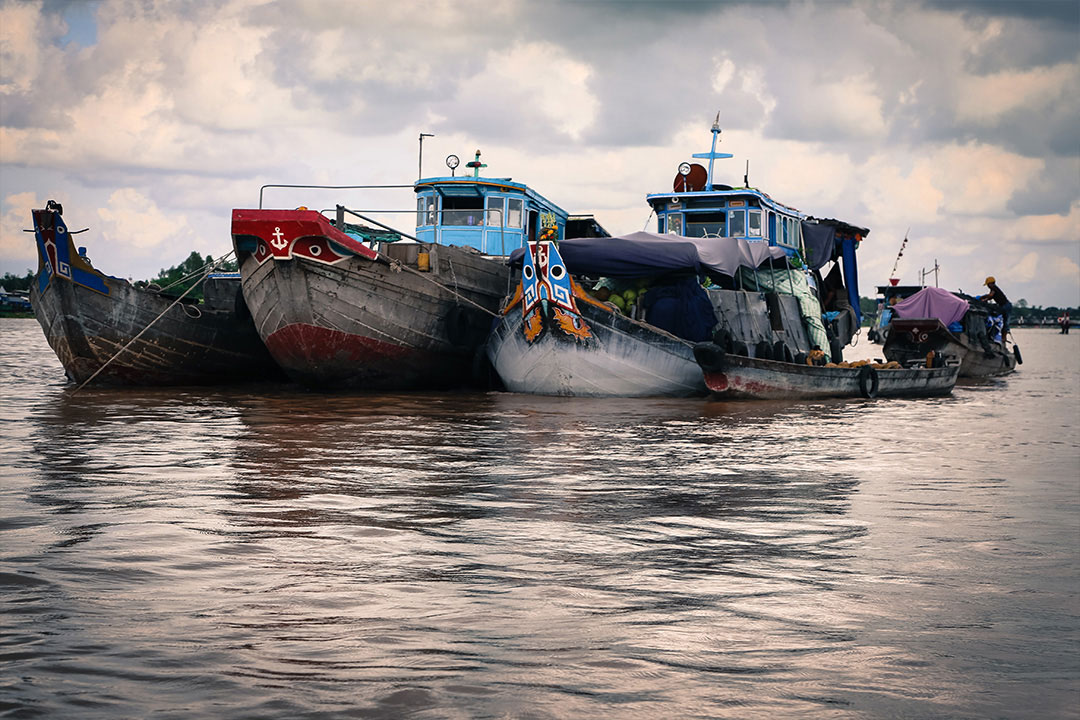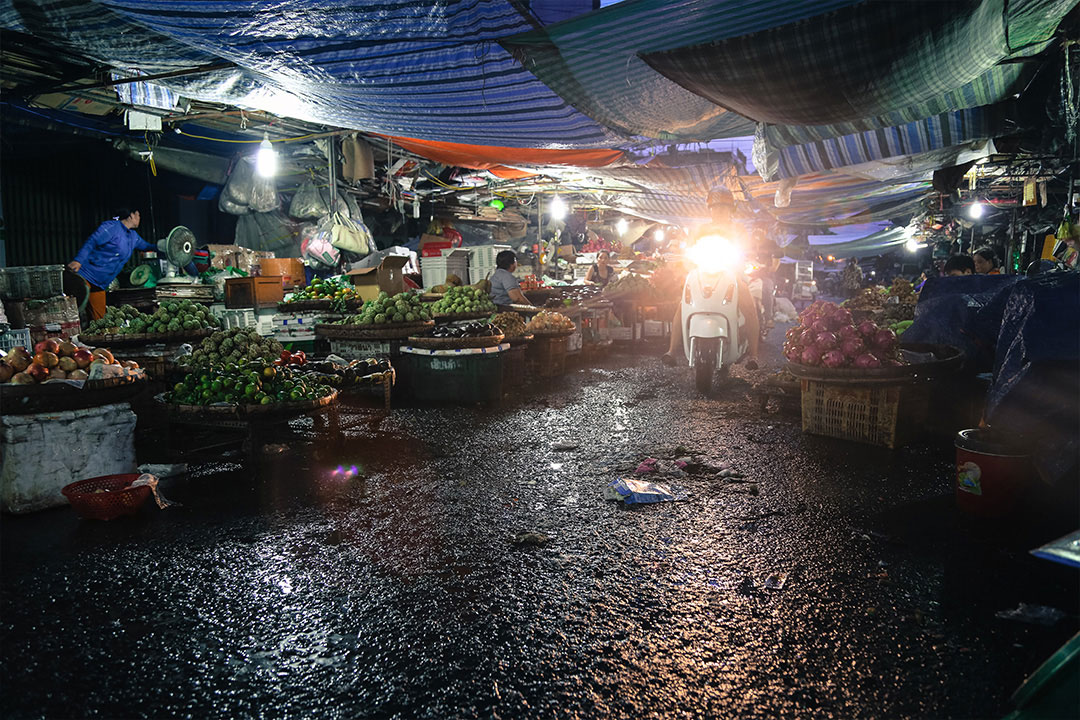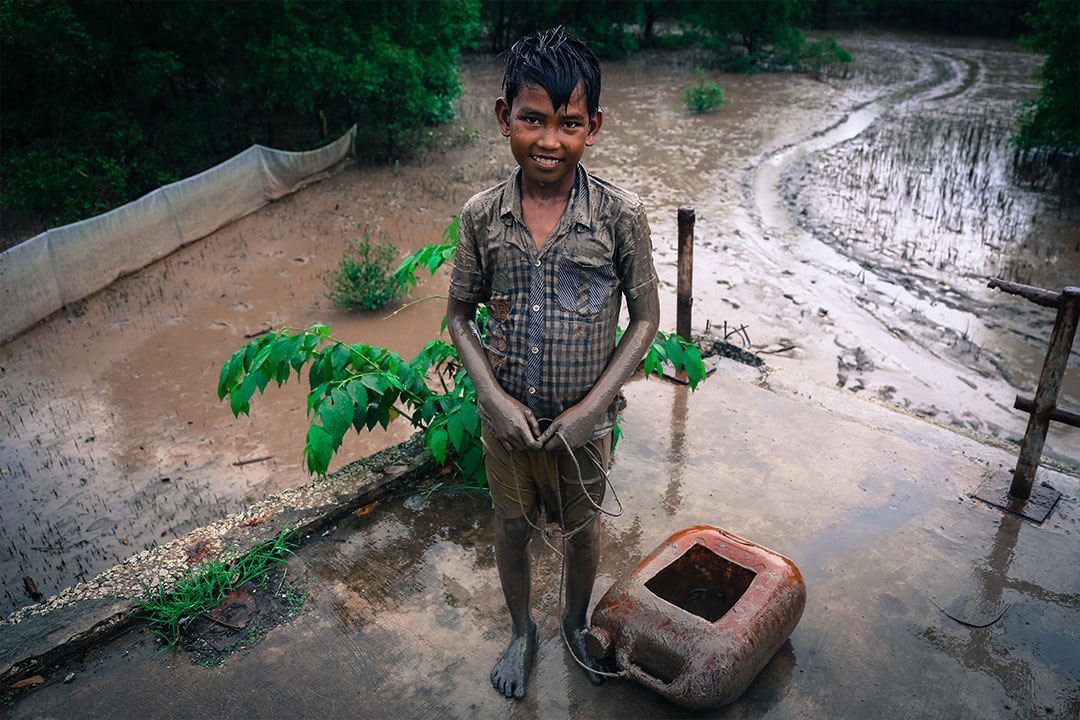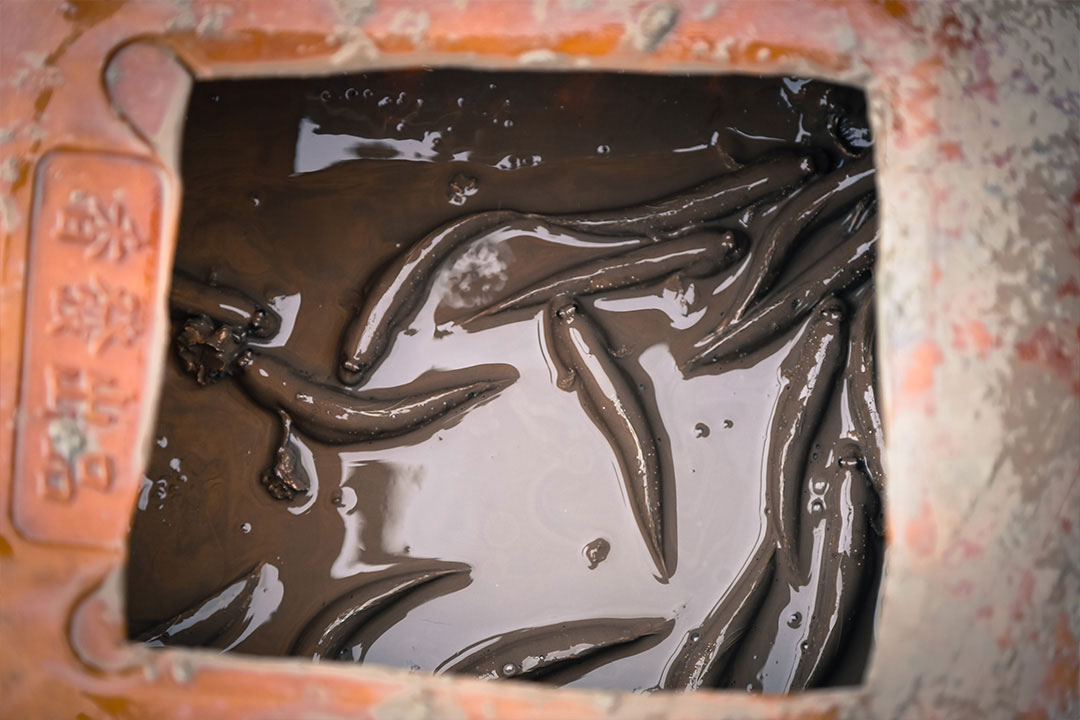The Fertile Mekong Delta Imperiled
Rice and fish farmers battle against drought, climate change, rising sea levels, the impact of dams, and salt intrusion.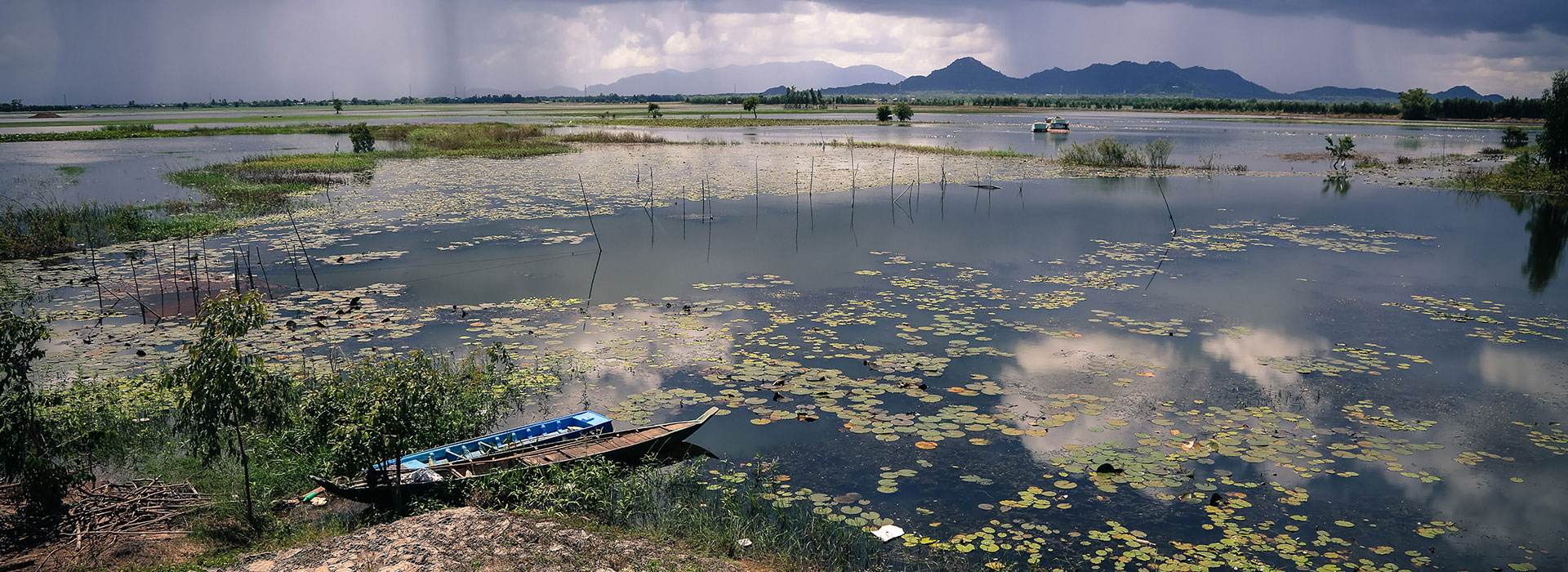
Location: Vietnam
A hundred years ago the Mekong Delta was a nearly impenetrable swamp. Today it’s Vietnam’s rice bowl, but a much imperiled one. This vast wetland inhabited by 18 million people—roughly 20 percent of the country’s population—produces half of the nation’s rice crop and most of its fish and fruit.
An agricultural revolution that followed the Communist victory in South Vietnam in 1975 encouraged intensified rice farming, the clearing of mangroves, and the widespread construction of dikes to prevent the flooding of rice fields. This has devastated much of the region’s biodiversity.
Here one can see many Vietnamese who long depended on rice farming facing the impact of El Nino-induced drought, climate change, a damaging focus on producing more and more rice, a loss of sediment to upstream dams, rising sea levels, and a subsequent intrusion of damaging salt water.
Approaching the northern Delta on the Hau River, I visit a Cham village that lies behind a curtain of mangroves and Nipa palms. Children play on a long rickety jetty, leaping into the river as a warm rain sets in. The Cham people are a Muslim minority and one of the oldest communities to settle in this area. Their homes are set on high stilts, and the ground is slippery clay. This is a town designed to ride out the annual flood season.
We visit the village headman, a trim and handsome man with a grey beard who is dressed in a plain white shirt and sarong. The sky darkens as we retreat under his house. He tells me that when he was a child in the 1940s the flood waters would rise in October and September and turn red with silt. The fish came with this red tide, migrating from the river to forests and fields to lay their eggs. The people would harvest fish from their rice fields, a bounty carried in the river’s pulse. But he says that in the last few years the river has remained the same grey color all year round. There are no fish to catch. He says that he’s not sure if it’s because of the dikes and land being drained for farms. In his opinion, the real change is that upstream dams have blocked the floodwaters and migrating fish.
But experts say that the dams alone are not destroying the river. The river’s degradation is also the result of overcropping, overfishing, sand dredging, reengineering, water pollution, and climate change.
Fear of the river’s water
“The river was more beautiful before, cleaner and healthier. ”
- Cham village headman
“The river is our friend,” the headman says. “It has a spirit.”
He smiles sadly, “It was more beautiful before, cleaner and healthier. The children never had sickness.”
The headman believes that the water must contain chemicals because it’s starting to make people sick. As I travel down the river such accounts echo from northern Thailand to Cambodia’s Tonle Sap, and now I hear the same thing here. People are becoming afraid of what’s in the river water that flows through the center of their lives.
As wild fish disappear from the river, fish farms have become perhaps the second most numerous enterprise in the Chau Doc area. At one of these farms, a floating wooden building is one of thousands of such pontoons moored three and four deep along each side of the river. Stacked head-high under the veranda are sacks of fish meal, food for the fish teeming under the floorboards. When we arrive feeding is underway, a pungent industrial operation. In a hole in the wooden floor the water explodes into a silvery frenzy of heads and tails as the feed reaches the water.

The farm owner explains that the fish grow for 10 months. He sells one batch of fish every year to a Vietnamese fish-processing company for export to Japan, the U.S., and China. The stock of fish farmed in Vietnam’s delta is now greater than that from its other freshwater and seawater fisheries combined. The farmer says that they don’t eat their own stock. It’s taboo, bad luck. He tells me that when he was a child, they could catch fish off the side of their boat. Nowadays they buy fish from the market. This year when the water was very low, the oxygen levels fell dramatically and the fish suffocated in the intensively packed cages. They improvised by putting a boat in front of the farm and ran the propeller to force aerated water through the cages.
We drive to the nearby province of An Giang to meet with farmers who are resting from the day’s labor. We order coffee and sit around a knee-high concrete table on the roadside. The roads here all run along the dikes. They explain that land outside the dikes is vulnerable to salt incursion, and they only grow one crop of rice each year. However, even within the dikes, the impact of upstream dams is felt through the silt being blocked by the dams. Estimates suggest that the dams in China and Cambodia alone will stop as much as half of the Mekong’s sediment load from reaching the Delta.
The farmers explain that the loss of silt decreases the quantity and quality of their rice, while increasing their production costs. Normally floods bring silt and nutrients while also destroying pests and weeds, drowning the grasses, insects, and mice. The water also washes away bacteria that grow on the dead stalks of previous crops. All of this biomass decays and becomes nutrients fertilizing the soil. Without the nutrient-rich floods, the farmers must increasingly turn to fertilizers and pesticides. The rice crop is of poorer quality and fetches less on the market. Costs go up and returns fall.
One farmer says, “When there’s no flood, sadness fills the air. It’s all we talk about, how there are no fish, no floods, no lotus flowers.”
“When there’s no flood, sadness fills the air. It’s all we talk about, how there are no fish, no floods, no lotus flowers.”
- An Giang Farmer
“We used to have annual increases that rose gradually. Now the Chinese just release the water when they feel like it. It means that China controls the water and China controls if we live or die.”
So far the changes in the Mekong River have not stopped them from growing rice year-round. They have sufficient irrigation. The impact has been much worse nearer to the sea where the salt water has invaded normally freshwater areas. In some places the land is almost unrecoverable.
We continue our drive south. As night falls, the rain thickens until we are sloshing through the darkness blinded by oncoming headlights on increasingly narrow and potholed roads. The next morning in Soc Trang we meet with workers from the local government who report that this year the salt water intrusion reached 60 kilometers, or nearly 40 miles upstream and stayed at that point for four months. In a normal year, the salt only reaches 39 kilometers upstream and only for a few days. This year roughly half of all farming areas in the Delta were affected by salt. If they had had no dikes, the losses would have been total.
They explain that the crisis is due both to a lack of fresh water caused by upstream dams and to climate change, which results in less rain but causes rising seas. A closed dike can protect a rice field as long as there is enough fresh water inside, but if not, then the field becomes a rapidly shrinking island in the seawater.
The men and the young are leaving
Just to the south of Soc Trang city is the district of Huyen Tran De. I speak with a group of men playing Pétanque under old shade trees. The oldest man there says that everyone here has lost land to salt. Although he was able to grow a small crop, his harvest only generated a small return.
He says that since he was born, the river flooded every year with freshwater from upstream. But now when the river should be high, outside the sea gates he finds nothing but salt. The precarious life of farmers is such that, after one year lost to salt, families have been broken apart. The old man says, “You can see for yourself, there are fewer young people here now. Old men raise babies so that the children’s parents can go to find work.”
Outside the dikes, the poorest people are facing the brunt of upstream change and rising sea levels. The closer we get to the sea, the towns thin and trees disappear until we find ourselves crossing between open shrimp ponds in a scrubby barren and brackish landscape. We stop in a little village where houses cling to the clay sides of the raised road, and speak with the community in a local shop.
There are no men or young adults here. The group that eagerly gathers to speak with us is composed of grandmothers and young children. They tell us “the loss of water is the biggest suffering.” During the drought there was no fresh water here—none for the people, animals, or crops. The government supplied drinking water for two months, but then the trucks stopped and they were forced to rely on privateers selling bottled water at vastly inflated prices. The river was too salty even to wash their clothes in.
These families used to have rice fields, but the salt poisoned the ground. Now the land has been bought by outside investors and turned into a shrimp farm. The money ran out, so all of the parents left to find work. They come home to see their children once each year during the Tet holiday. As we leave, rain starts to fall, and buckets of every description are quickly put into position under the eaves to catch the fresh water.
Crossing a huge bridge we see the mouth of one of the Mekong’s nine dragons. This is the River Hau, located a few miles to the east. Moments later we stop beside a small home set on the edges of a mangrove swamp. There a grandmother is raising eight children. She explains that they make their living in the tidal zone where the Mekong joins the sea.
There they hunt for crabs, shrimp, and mudskippers. If they catch enough fish to eat and some left over to sell, the money buys rice. When they don’t get enough, she adds sugar to hot water to make a soup for the children. Ten years ago, she says, there were more fish. Now the fish have disappeared. She thinks that it’s the clearing of all the mangroves and dredging of canals that caused this.
We walk with them to the river mouth where they borrow mud sleds, a local invention designed to skate over the knee-deep mud flats. With the adults kneeling on the runner board, the babies are loaded into a front tray where the catch is to be thrown, and they push off through the mangroves.
We wade through silt that managed to reach here all the way from the Himalayan Plateau and down through Southeast Asia.
The grandmother wipes mud from the faces of her two baby grandchildren and reveals angry welts and red puffiness around their eyes and cheeks.
“It’s the rain,” she says, “Every time the rain falls and runs from the fields into the river, the children’s faces break out in these rashes.”
